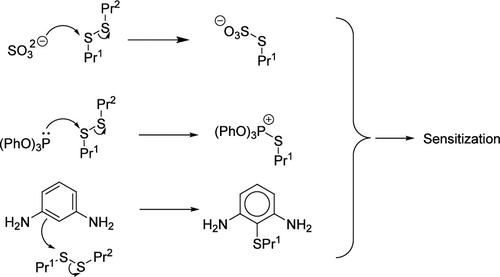Updating Reaction Mechanistic Domains for Skin Sensitization: 1. Nucleophilic Skin Sensitizers
IF 3.7
3区 医学
Q2 CHEMISTRY, MEDICINAL
引用次数: 0
Abstract
It has long been recognized that skin sensitizers either are electrophilic or can be activated to electrophilic species. Several nonanimal assays for skin sensitization are based on this premise. In the course of a project to update dermal sensitization thresholds (DST), we found a substantial number of sensitizers, with no electrophilic or pro-electrophilic alerts, that could be simply explained in terms of the sensitizer acting as a nucleophile. In some cases, the nucleophilic center is a sulfur or phosphorus atom, while in others, it is an aromatic carbon atom. For carbon-centered nucleophiles, a quantitative mechanistic model based on a combination of Hammett σ+ and logP values has been derived. This has been applied to rationalize several groups of known sensitizers with no electrophilic or pro-electrophilic alerts, including anacardic acids and cardols, which are known human sensitizers associated with, inter alia, cashew nut oil, mango, and Ginkgo biloba. The possibility of nucleophilic sensitization needs to be considered when evaluating new chemicals for skin sensitization potential and potency by nonanimal assays, particularly those based on the premise that skin sensitization is dependent upon reactions of electrophiles with skin protein-based nucleophiles.

更新皮肤过敏的反应机制域:1.亲核皮肤致敏物质
人们早已认识到,皮肤致敏物质要么是亲电的,要么可以活化为亲电物种。几种非动物皮肤过敏检测方法都是基于这一前提。在更新皮肤过敏阈值(DST)的项目过程中,我们发现有相当多的敏化剂没有亲电或亲电警报,可以简单地用敏化剂作为亲核体来解释。在某些情况下,亲核中心是一个硫或磷原子,而在另一些情况下,亲核中心是一个芳香碳原子。对于以碳为中心的亲核物,我们已根据哈米特 σ+ 和 logP 值的组合推导出一个定量机理模型。该模型已被用于合理解释几组没有亲电或亲电警报的已知敏化剂,包括无铬酸和棉酚,它们是与腰果油、芒果和银杏叶等有关的已知人体敏化剂。在通过非动物实验评估新化学品的皮肤致敏潜力和效力时,需要考虑亲核致敏的可能性,特别是那些以皮肤致敏取决于亲电体与皮肤蛋白质亲核物的反应为前提的评估。
本文章由计算机程序翻译,如有差异,请以英文原文为准。
求助全文
约1分钟内获得全文
求助全文
来源期刊
CiteScore
7.90
自引率
7.30%
发文量
215
审稿时长
3.5 months
期刊介绍:
Chemical Research in Toxicology publishes Articles, Rapid Reports, Chemical Profiles, Reviews, Perspectives, Letters to the Editor, and ToxWatch on a wide range of topics in Toxicology that inform a chemical and molecular understanding and capacity to predict biological outcomes on the basis of structures and processes. The overarching goal of activities reported in the Journal are to provide knowledge and innovative approaches needed to promote intelligent solutions for human safety and ecosystem preservation. The journal emphasizes insight concerning mechanisms of toxicity over phenomenological observations. It upholds rigorous chemical, physical and mathematical standards for characterization and application of modern techniques.

 求助内容:
求助内容: 应助结果提醒方式:
应助结果提醒方式:


